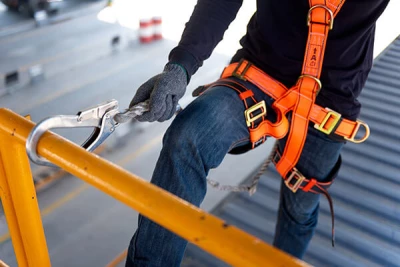Our Safety Culture
Published 1.3.2023
Happy New Year and welcome to 2023, everyone! There's a saying that safety is everyone's responsibility, but what about culture? How does culture affect safety and our work environment as a whole? What is culture and why is it important to businesses? It can be defined in many ways, put simply, "culture is the character and personality of an organization."
Over the last several years, we have been emphasizing the importance of our safety culture and how this philosophy permeates the daily activities of everything we do on the job site and at home. How we achieve this is based upon our individual values and how we influence others, it is our attitudes towards safety and patterns of behavior that determine our commitment to the overall success of this culture. Everyone plays a part in building the culture (or breaking it). When it comes to safety, the value of caring about your own well-being as well as those around you builds our culture. Actions such as following safety rules, safe work practices, and stopping work to address hazards are some basic examples of living the core value of caring about everyone’s well-being on the job.
With that, we can conclude that an organization's culture is closely connected to safety on the job. When we all choose to work safely and we care about the well-being of each other, the culture is strengthened. When the culture is strong, you can trust everyone to do the right thing every time, meaning that rules and discipline are not needed to enforce safety; it just becomes what is done.
Therefore, it is vital that every HBI employee, regardless of their position or job, has a personal commitment and responsibility for the safety of themselves and others. Safety is a value that must be held by everyone, and this value is a cornerstone for our culture. This year, stand up and be a safety leader and you will make sure everyone goes home safe every day. When that personal commitment is made and honored by everyone, we will all be achieving our goal of having created the best safety culture in the industry!
Remember This!
"Our commitment to the health and safety of our employees is uncompromising. Our success is derived from the obligation to one another that we all go home safely every day."
Frostbite and Hypothermia
Published 1.17.2023
Since we learned about the Wind Chill Index last week, it is a good idea to discuss the effects of cold weather injuries this week. Frostbite and hypothermia are cold-related emergencies that may quickly become life or limb threatening if we do not know what to do.
What does frostbite look like?
- Lack of feeling in the affected area
- Skin that appears waxy, is cold to the touch, or is discolored (flushed, white or gray, yellow or even blue).
How to care for someone experiencing frostbite?
- Move the person to a warm place
- Handle the area gently and never rub the affected area
- Gently warm by soaking the affected area in warm water (100-105 degrees F) until it appears red and feels warm
- Loosely bandage the area with dry, sterile dressings
- If the person's fingers and toes are frostbitten, place dry, sterile gauze between them to keep them separated
- Avoid breaking any blisters
- Do not allow the affected area to refreeze
- Seek professional medical care as soon as possible
Hypothermia is another cold-related emergency and is caused by the cooling of the body caused by the failure of the body’s warming system. The goals of first aid are to restore normal body temperature and to care for any conditions while waiting for EMS personnel.
Signals of hypothermia include,
shivering, apathy, loss of consciousness, numbness, weakness, glassy stare, and impaired judgement.
What to do for hypothermia
- Call 9-1-1 or the local emergency number
- Gently move the person to a warm place
- Monitor breathing and circulation. Give rescue breathing and CPR if needed
- Remove any wet clothing and dry the person
- Warm the person slowly by wrapping in blankets or by putting dry clothing on the person. Hot water bottles and chemical hot packs may be used when first wrapped in a towel or blanket before applying. Do not warm the person too quickly, such as immersing them in warm water, because rapid warming may cause dangerous heart arrhythmias. Warm the core first (trunk & abdomen), rather than the extremities (hands & feet). This is important to mention because most people will try to warm hands and feet first and that can cause shock.
Asbestos Awareness
Published 1.24.2023
Some workplace hazards have an immediate effect, causing an injury or illness you can’t miss. Others, such as asbestos, take many years to do their damage.
As insulators, firestoppers and carpenters we have encountered Asbestos probably more than any other trade in the construction industry. Some of those at Hudson Bay may have even installed it years ago or began their careers doing abatement on this deadly material and if you have been in our industry long enough you probably know someone who has succumbed to the lethality of asbestosis or mesothelioma.
What is Asbestos?
Asbestos is a naturally occurring mineral used for fireproofing and many other applications. It is mined from rock in the form of a fiber that can be spun or woven into fabric and other products. Asbestos does not burn. It is flexible, strong, resistant to chemical damage, an insulator against heat and inexpensive. It was known as the “miracle mineral” and its many qualities led to widespread use before the serious health effects were common knowledge. When asbestos or asbestos-containing materials break apart, they release tiny fibers that can be breathed in. These fibers lodge in the lungs where they set off a serious illness.
What is Asbestosis?
Asbestosis is a chronic respiratory condition. The inhaled fibers irritate the lung tissues and cause scarring. Symptoms include shortness of breath and a crackling sound in the lungs when inhaling. The disease is disabling and usually fatal. Workers who have renovated or demolished buildings containing asbestos may be at risk. Lung cancer is the cause of most deaths from asbestos exposure. Mining, milling, manufacturing and use of asbestos and asbestos products puts the worker at risk. Symptoms include a cough, change in breathing and shortness of breath. Smoking in combination with asbestos exposure increases risk of lung cancer.
Mesothelioma is a rare form of cancer, usually occurring in the thin membrane lining of the lungs, chest, or abdomen. It is almost always linked to asbestos exposure.
To protect yourself from exposure, you need to know where asbestos is likely to be found on the jobsite. Head warning signs and markings. If in doubt, ask a superintendent or a foreman or a member of the Hudson Bay Safety Team.
Remember This!
HBI employees are not to remove or purposely make friable any known or suspected asbestos containing material. If you think the material is or contains Asbestos, leave the area and contact your supervisor immediately.
Leave Yourself an Out
Published 1.31.2023
All too often, people are injured at work due to putting themselves in the line of fire or finding themselves in a place where they cannot escape danger. There are many different examples of these types of incidents. From a dropped load falling onto your foot to rear-ending the car in front of you, there are many scenarios like these incidents that are preventable if you leave yourself an out.
What does it mean to leave yourself an out? For the purpose of this toolbox talk, we will define it as, “the ability to escape danger if a negative situation occurs.”
The term “leaving yourself an out” is often used in defensive driving courses. These courses always stress that no matter what the situation is, you need to be on defense at all times. Being a defensive driver allows you to avoid preventable collisions. Situations such as a car in front of you braking unexpectedly or a driver swerving into your lane are unsafe acts that can put you at risk for serious injury if you are not prepared to react. A defensive driver always has an “out” so that they can react to changing conditions around them and have a safe option to take to avoid a collision.
The most common scenarios that result in injury are,
- Workers should never put themselves in a position where a load can strike them, if it falls. Consider giving extra space for whatever the work task is, in case conditions change or something fails.
- All too often, employees find themselves in a position where an operator of a piece of heavy equipment or a driver of a vehicle does not see them. The problem with this scenario is that when the individual does have an "out", they will be struck. If you have an out, even if you find yourself in the line of fire, you may be able to escape danger and avoid serious injuries or worse.
Strive to remove yourself from being directly in the line of fire - such as under a lifted load or behind a backing vehicle. Even when you are not directly in the line of fire, you should consider what your options are if conditions change, and a negative situation occurs.





